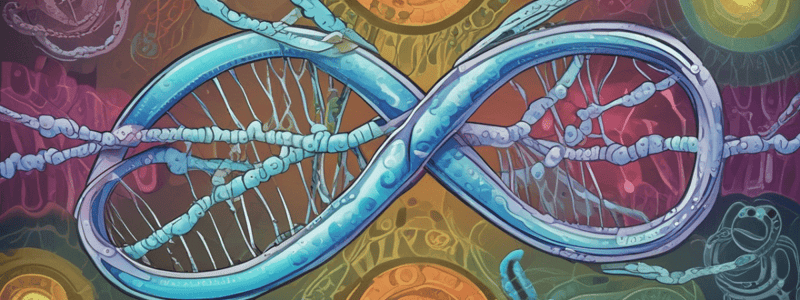Podcast
Questions and Answers
Which mechanism is not one of the contributors to chromosomal genetic variation?
Which mechanism is not one of the contributors to chromosomal genetic variation?
- Independent assortment of chromosomes
- Random fertilization
- Crossing over
- Mutations (correct)
How many possible combinations of chromosomes are there for a human based on independent assortment alone?
How many possible combinations of chromosomes are there for a human based on independent assortment alone?
- 16,777,216
- 70 trillion
- 8,388,608 (correct)
- 23
What is the total number of possible offspring combinations due to random fertilization in humans, excluding crossing over?
What is the total number of possible offspring combinations due to random fertilization in humans, excluding crossing over?
- 64 trillion
- 70 trillion (correct)
- 8 million
- 8.4 million
During which phase is a cell cycle typically arrested for karyotype analysis?
During which phase is a cell cycle typically arrested for karyotype analysis?
What is an example of a genetic condition arising from incorrect chromosome number?
What is an example of a genetic condition arising from incorrect chromosome number?
Which process during meiosis can produce four genetically unique daughter cells?
Which process during meiosis can produce four genetically unique daughter cells?
Which symptom is associated with Downs Syndrome?
Which symptom is associated with Downs Syndrome?
What is a characteristic physical feature of Turner Syndrome?
What is a characteristic physical feature of Turner Syndrome?
Which syndrome is characterized by the presence of an extra chromosome 18?
Which syndrome is characterized by the presence of an extra chromosome 18?
What is a common feature of Kleinfelter's Syndrome?
What is a common feature of Kleinfelter's Syndrome?
Which condition involves nondisjunction of the 21st chromosome?
Which condition involves nondisjunction of the 21st chromosome?
Which genetic disorder results in a child having 45 chromosomes?
Which genetic disorder results in a child having 45 chromosomes?
What neurological problem is commonly seen in Patau Syndrome?
What neurological problem is commonly seen in Patau Syndrome?
Which of the following describes the 'somatic cell'?
Which of the following describes the 'somatic cell'?
What is a common symptom of Turner Syndrome related to hearing?
What is a common symptom of Turner Syndrome related to hearing?
Which term refers to the exchange of genetic material between homologous chromosomes?
Which term refers to the exchange of genetic material between homologous chromosomes?
Flashcards are hidden until you start studying
Study Notes
Factors that Give Rise to Genetic Variation
- The behavior of chromosomes during meiosis and fertilization reshuffles alleles and chromosomes every generation
- Three mechanisms contribute to chromosomal genetic variation:
- Independent assortment of chromosomes
- Crossing over
- Random fertilization
Independent Assortment
- The "2n rule" states that the number of possible chromosome sorting combinations is 2^n
- For humans (n = 23), there are 2^23 = 8,388,608 possible combinations of chromosomes based on independent assortment alone
- With n=2, there are 4 possibilities and 8 possible combinations of chromosomes
Random Fertilization
- 8,388,608 possible gametes x 8,388,608 possible gametes = >70 trillion possible offspring (excluding cross over)
Human Metaphase Plate
- Cell cycle is arrested at metaphase
- Chromatids are purified, Giemsa stained, and analyzed for number and rearrangements
Cross Over
- Early in Meiosis I, a pair of homologs is held together during synapsis
- A single crossing over event leads to 4 genetically unique daughter cells
When Things Go Wrong
- Aneuploidy: any deviation from the normal number of chromosomes, usually meaning a cell nucleus possessing too many or too few chromosomes
- Somatic aneuploidy: non-heritable and has a localized effect
Genetic Disorders
- Down Syndrome:
- Low muscle tone
- Single deep crease across center of palm
- Looseness of joints
- Small skin folds at the inner corners of the eyes
- Excessive space between first and second toe
- Mental retardation (mild to severe)
- Trisomy 21: results in characteristic facial and body patterns, varying mental abilities
- Kleinfelter's Syndrome:
- Male child with an extra X chromosome
- Development of breast tissue
- Little body hair
- Tall stature
- Small testes
- Infertility
- Evidence of mental retardation may or may not be present
- Patau Syndrome (Trisomy 13):
- Polydactyly
- Deformed/rocker-bottom feet
- Neurological problems
- Microcephaly
- Severe mental deficiency
- Facial defects
- Edwards' Syndrome (Trisomy 18):
- Low birth weight
- Prominent occiput
- Clubbed hands
- Neurological problems
- Severe development delays
- Facial defects
- Turner Syndrome:
- Nondisjunction of the X
- Sterile females with webbed necks, shortened torso
- 45 chromosomes - XO not XX
Characteristics of Turner Syndrome
- Short stature
- Failure of ovaries to develop (90-95%)
- Webbed neck (25%) or short neck (40%)
- Abnormal fingernails and toenails (70%)
- Low hairline at neck (40%)
- Heart defect (30%)
- Kidney or urinary tract defect (30%)
- Hearing disorders (50-90%)
- Frequent ear infections in childhood (75%)
- Shortening of bones in the hands (35%)
- Lower jaw smaller than normal (60%)
- Drooping eyelids (ptosis), wandering eyes (strabismus)
Terms to Know
- Mitosis: Clonal division - somatic cells
- Meiosis: Reductive division-gametes
- Somatic cell: all the cells of a multicellular organism except the gamete-forming cells
- Chiasmata: the structure that forms at the crossover points after genetic material is exchanged
- Crossing over: the exchange of genetic material between homologous chromosomes resulting in chromosomes that incorporate genes from both parents
- Recombinant: describing something composed of genetic material from two sources
- Reductive division: a nuclear division that produces daughter nuclei each having one-half as many chromosome sets as the parental nucleus
- Synapsis: the formation of a close association between homologous chromosomes during prophase I
- Tetrad or Bivalent: two duplicated homologous chromosomes (four chromatids) bound together by chiasmata during prophase I
Studying That Suits You
Use AI to generate personalized quizzes and flashcards to suit your learning preferences.




